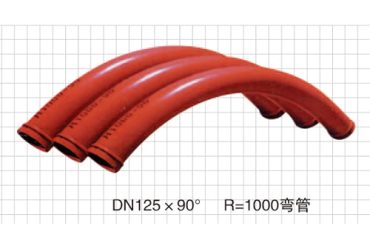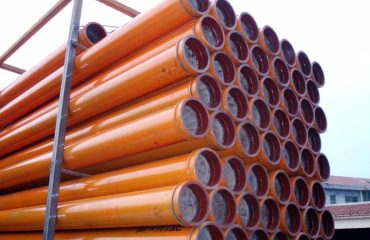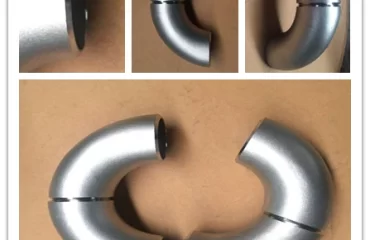Dòng chảy trong một đường ống
Dòng chất lỏng chảy trong ống phụ thuộc vào áp suất tác dụng, bán kính của đường ống và
độ nhớt của chất lỏng. Đối với một chất lỏng Newton, dòng chảy tỉ lệ thuận với
độ nhớt, đó là một hằng số. Đối với một chất lỏng phi Newton có một độ nhớt mà phụ thuộc
3
khi sự căng thẳng cắt, như Vữa và bê tông, tốc độ dòng chảy là một hàm phức tạp
độ nhớt.
Độ nhớt () của một chất lỏng là tỷ số giữa ứng suất cắt () với tốc độ cắt (̇):
= / ̇. Định nghĩa này thuận tiện cho chất lỏng Newton, và một số phi Newton
chất lỏng. Trong các trường hợp khác, Tuy nhiên, một phương pháp kỹ thuật để mô tả một hộp chất lỏng
đơn giản hóa việc phân tích. Ví dụ, nếu chất lỏng gần đúng là chất lỏng có định luật lũy thừa, nó có thể
được mô tả bởi phương trình. 1 trong đó τ là ứng suất cắt, K chỉ số nhất quán luật lũy thừa, ̇
tốc độ cắt, n số mũ luật lũy thừa:
n = kg [ 1]
Biên dạng vận tốc tương ứng trong một ống tròn sau đó được cho bởi phương trình 2 [4]:
1 1/
2
(3 1) ( ) 1 ( ) ( 1)
N
p p
Qn r v r
p Rn R
+ + = − +
[ 2]
trong đó v là vận tốc chất lỏng là hàm của vị trí hướng tâm, r , trong đường ống, Q cái
tốc độ dòng chảy thể tích, và Rp bán kính ống. Chỉ số nhất quán của luật năng lượng chất lỏng, K,
có thể được tính bằng phương trình sau 3 [4], đòi hỏi phải giảm áp suất
đo trên một độ dài nhất định:
3 3 1/
2
N
N
P
P Q K R
L p
∆ − − =
[ 3]
trong đó ∆P là độ giảm áp suất, và L khoảng cách giữa các cảm biến áp suất. Các
số mũ n và hệ số K cũng có thể được xác định thông qua phương trình 1 từ lưu biến
đo chất lỏng thông qua máy đo lưu biến nếu có. Nhưng phương trình 2 và 3 có thể
cũng được sử dụng để xác định n và K từ dòng chảy trong ống, trong trường hợp không có máy đo lưu biến phù hợp.
Tốc độ cắt ở bề mặt tường được tính theo phương trình sau [5, 6]:
3
3 1 ( ) P
P
n Q r R
n r c
P
+ = = [ 4]
Ứng suất cắt cục bộ là
t = drp l / 2 [ 5]
Các phương trình 1 bởi vì 5 mô tả dòng chất lỏng đồng nhất trong ống.
Tuy nhiên, bê tông là một chất lỏng phức tạp hơn vì nó chứa cốt liệu với phạm vi rộng
4
phạm vi kích cỡ. Các cốt liệu này tương tác với thành ống và với nhau, tạo ra
sự không đồng nhất trong chất lỏng. Như vậy, dòng chảy bê tông trong đường ống thường xảy ra trong ba lớp
hoặc vùng [5, 6] như thể hiện trong hình 1:
• Lớp trượt hoặc lớp bôi trơn,
• Vùng hoặc lớp cắt, và
• Lớp bê tông bên trong, còn được gọi là lớp luồng cắm
Độ dày của lớp trượt phụ thuộc vào ma sát của vật liệu liền kề
đến vật liệu ống. Ma sát học là “khoa học và công nghệ liên quan đến việc tương tác
bề mặt chuyển động tương đối, bao gồm cả ma sát, bôi trơn, mặc, và xói mòn” [7]. Các
độ dày của, và hồ sơ vận tốc trong, lớp cắt phụ thuộc vào
độ nhớt và ứng suất. Độ dày của lớp bên trong phụ thuộc vào năng suất
nhấn mạnh.
Thành phần và đặc tính vật lý của từng lớp rất khó biết.
Đặc tính của chúng đòi hỏi phải khai thác vật liệu từ các vùng khác nhau. Các
Lớp trượt/bôi trơn chứa chủ yếu là xi măng và có thể có các hạt cát rất nhỏ
[8], trong khi lớp bên trong chứa cốt liệu thô. Cũng, đường kính của lớp bên trong
hoặc độ dày của lớp trượt không xác định. Có thể hình dung rằng dự đoán của bê tông
dòng chảy trong đường ống sẽ cần đặc tính của từng lớp.
Nhân vật 1: Hồ sơ dòng chảy của bê tông trong đường ống [6]
2.2. Lớp trượt
Một số nhóm nghiên cứu đã nghiên cứu lớp trượt của dòng bê tông trong
ống. Choi và cộng sự. [5, 6] Đo độ dày lớp trượt bằng máy siêu âm
Trình phân tích vận tốc (RRP) trong mạch bơm sử dụng thiết bị công nghiệp và nhận thấy rằng
có một 2 lớp dày mm dọc theo bề mặt bên trong của ống. Tuy nhiên, lớp
độ dày có thể thay đổi tùy thuộc vào tỷ lệ hỗn hợp và cấu hình đường ống.
Kaplan [9] báo cáo rằng dòng chảy của bê tông trong đường ống chủ yếu liên quan đến
độ nhớt của lớp trượt và các đặc tính của nó có thể được đo bằng phép đo ma sát. Anh ta
nhận thấy rằng mối tương quan giữa các tính chất của vật liệu khối được đo bằng
5
lưu biến kế và tính chất của lớp trượt yếu. Jacobsen và cộng sự. [10] cho thấy bởi
sử dụng bê tông màu mà đặc tính vận tốc của bê tông giống với đặc tính của nút
dòng chảy ở tâm ống, và lớp trượt không chuyển động, tương tự như trong hình 1.
Kwon và cộng sự.[11, 12] đo tính chất lưu biến của bê tông trước và sau
sau khi bơm đồng thời theo dõi áp suất và tốc độ dòng chảy và nhận thấy rằng mặc dù có
không có mối tương quan giữa các đặc tính lưu biến của bê tông khối, ví dụ., độ nhớt và năng suất
nhấn mạnh, và tốc độ dòng chảy, có mối tương quan chặt chẽ giữa tính chất của lớp trượt
và tốc độ dòng chảy. Vì vậy họ suy luận rằng lớp trượt là yếu tố quyết định
dự đoán bê tông sẽ chảy trong đường ống. Sau đó họ tiến hành phát triển một máy đo ma sát
đó là một máy đo lưu biến đồng trục với một quả lắc nhẵn được làm bằng thép hoặc được bọc bằng cao su để
mô phỏng lớp trượt của ống.
NGO và cộng sự.[13] quan sát thấy lớp trượt nằm giữa 1 mm đến 9 mm dày, bởi
hình dung dòng vật liệu trong máy đo lưu biến. Ông đã phân tích lớp này và thấy rằng nó
chứa cát có kích thước hạt nhỏ hơn 0.25 mm. Điều này có nghĩa là có một
sự di chuyển của cốt liệu thô từ gần thành tới tâm ống, nơi
tốc độ cắt thấp hơn so với tốc độ được tìm thấy gần các bức tường.
2.3. Áp suất bơm
Một yếu tố khác trong quá trình bơm là áp suất tác dụng lên vật liệu để di chuyển nó.
qua đường ống. Rio và cộng sự. [8] cho thấy với một số lượng lớn các thử nghiệm bơm rằng
mối quan hệ giữa áp suất của máy bơm và tốc độ dòng chảy của vật liệu là tuyến tính:
P k kQ = +1 2 [ 6]
Ở đâu 1 k và 2 k là hai tham số thực nghiệm phụ thuộc vào vật liệu và các thông số khác
điều kiện thí nghiệm. Rio và cộng sự. kết luận rằng hai tham số có thể được sử dụng để
mô tả một hỗn hợp cụ thể. Rio và cộng sự. [8] ủng hộ rằng sự hiểu biết về những điều này
các thông số cho một hỗn hợp cụ thể và mạch bơm có thể được sử dụng như một biện pháp kiểm soát chất lượng
Công cụ để đảm bảo rằng áp suất tác dụng đủ để đảm bảo tốc độ dòng chảy mong muốn.
Feys và cộng sự. [14] thiết lập mối quan hệ thực nghiệm giữa độ nhớt nhựa
của bê tông với tốc độ cắt là 10 s-1 và gradient áp suất trong đường ống. Nếu áp lực
độ dốc quá thấp, vật liệu sẽ không di chuyển qua đường ống. Feys đã đề cập đến hai
các vấn đề liên quan đến dự đoán dòng chảy trong đường ống: 1) ảnh hưởng của lớp trượt là rất
quan trọng, nhưng nó chưa được hiểu rõ và khó đo lường; 2) tốc độ cắt trong
đường ống thay đổi theo không gian và thời gian. Một giải pháp khắc phục tác dụng của lớp trượt
sẽ là để đo tính chất lưu biến của nó, nếu nó có thể được cô lập và chiết xuất.
Mô hình hóa dòng chảy trong đường ống có thể giúp giải quyết vấn đề thứ hai. Feys và cộng sự. [14] cũng thế
nhận thấy rằng việc bơm bê tông tự cố kết (SCC) đòi hỏi cao hơn
áp lực , trong khi áp lực năng suất gần như bằng không, nhưng độ nhớt của nhựa cao hơn thế
cho bê tông thường. Điều này có thể là do lớp trượt (Nhân vật 1) điều đó sẽ yêu cầu một
ứng suất cắt cao hơn ở cùng tốc độ cắt do độ nhớt tăng.
- TRANG CHỦ
- Về chúng tôi
- SẢN PHẨM
- Ống thép hợp kim
- Mặt bích ống thép
- Bộ giảm ống thép
- Khuỷu tay ống thép
- Có rãnh phù hợp
- Bơm bê tông và các bộ phận
- Đường ống bơm bê tông
- Máy bơm bê tông khuỷu tay
- Máy bơm bê tông kẹp
- Máy bơm bê tông Bend
- Mặt bích máy bơm bê tông
- Bê tông đặt Boom
- Phụ tùng bơm bê tông
- Bê tông bơm Piston
- Máy bơm bê tông cao su ống
- Máy bơm bê tông mặc tấm và đeo nhẫn
- Máy bơm bê tông xi lanh
- Máy bơm bê tông lót
- PUTZMEISTER
- SCHWING
- Đất vít cọc
- KHÁCH HÀNG & TRIỂN LÃM
- KIẾN THỨC CÔNG NGHỆ
- LIÊN HỆ VỚI CHÚNG TÔI




Bạn phải đăng nhập để gửi bình luận.